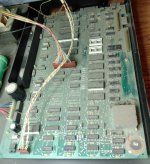Eudimorphodon
Veteran Member
ETA: Frustration! There aren't any unpopulated patterns on the board, drilled or not. So it looks like I'm limited to a piggyback hack (ugly, I agree) unless I want to buy a 3rd party upgrade board. So that kinda sucks.. and is likely why I've never done anything with it previously.
Any chance you could take a close-up picture of the RAM chip banks? Like I said earlier, I'm kind of surprised Commodore actually made machines with two banks of 4108 chips. (The 4108 isn't actually a "real" part, they were a way to sell 4116 16K chips that had an error in one half of the memory matrix but otherwise worked. There were even two SKUs for them depending on which half was bad, because it affected the RAS/CAS signal generation.)
(Just to sanity check, your machine actually says it's a 16K machine on the BASIC banner, right? It's not possible that someone upgraded or swapped the board for a 32K one already?)
As noted, if it is two banks of 4108s your options are an expansion board or unsoldering all the 4108s and replacing them with 4116s. The latter is straightforward enough (you just need to change a couple solder jumpers to let the multiplexing circuitry know about the change), but understandably not a thing you might be enthusiastic about doing. If you wanted to DIY your own expansion board it actually would be really trivial to make a 16K expansion board that hangs off those internal pin jumpers. Looking at the schematics I think it'd be easy to do with just two chips; so far as I can see all you'd need is a 16K or bigger SRAM, like these dirt common 32K ones, and something to decode it; a single 74LS00 NAND gate would do the trick. This would simply expand your RAM to 32K while continuing to use the onboard RAM for the lower 16K, not replace it like those fancier CPU socket boards.

